If you canoe or kayak the upper section of the Suwannee River in Northern Florida, you paddle through a wild and scenic world that seems like you’ve been transported to the 19th Century.
But when it comes time to make camp for the night, the unusual Suwannee River camping sites provide some of the most appreciated modern comforts. These five camps offer campsites where you can spread out your sleeping bag on a wooden platform with a roof and plug in your cell phone. There is screening to keep out mosquitos, lights, running water nearby and a bath house with hot water and flush toilets.

These camps, accessible only by river and spaced about 10 miles apart, are operated by Florida State Parks. They can be reserved in advance — and they’re free!
I’m not much of a camper, but these scenic river camps, with their protection from rain and bugs, seem like the perfect Suwannee River camping experience for me.
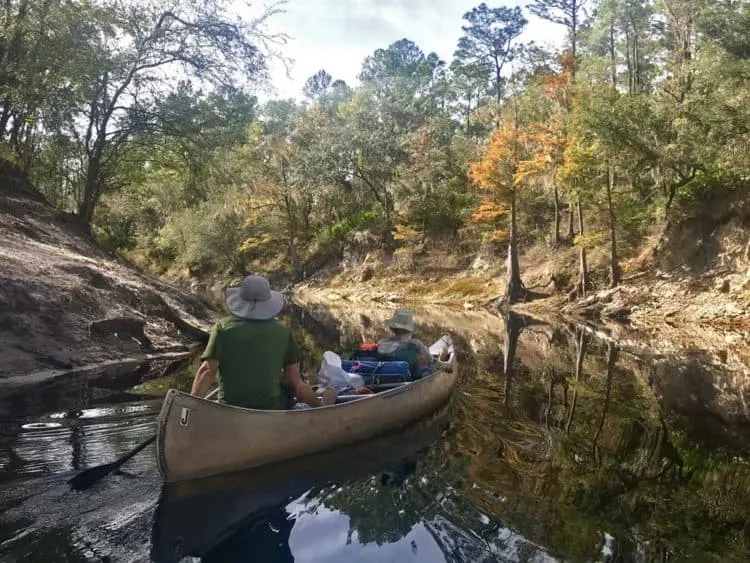
Paddling the lovely Suwannee River
I’ve paddled sections of the Suwannee before, and I keep returning because there is so much of it to see and, so far, it’s all beautiful.
The Suwannee River – alternately spelled Suwannee or, in the classic Stephen Foster song, Swanee — starts in the Okefenokee Swamp at the town of Fargo, Ga., and then travels 246 miles to the Gulf of Mexico.
Florida has created the Suwannee River Wilderness Trail, which is 170 river miles from Stephen Foster Folk Culture Center State Park to the Gulf of Mexico.
The river starts narrow and grows in width and depth as tributaries like the Alapaha and the Withlacoochee feed into it. It is a blackwater river, with water stained a dark orange from the decaying vegetation in the swamp where it originates.
Despite Florida’s rapid development, the Suwannee River is a remarkably wild and natural. There are only a few towns along its entire length and even when there are houses, many are built on bluffs out of sight from the river.
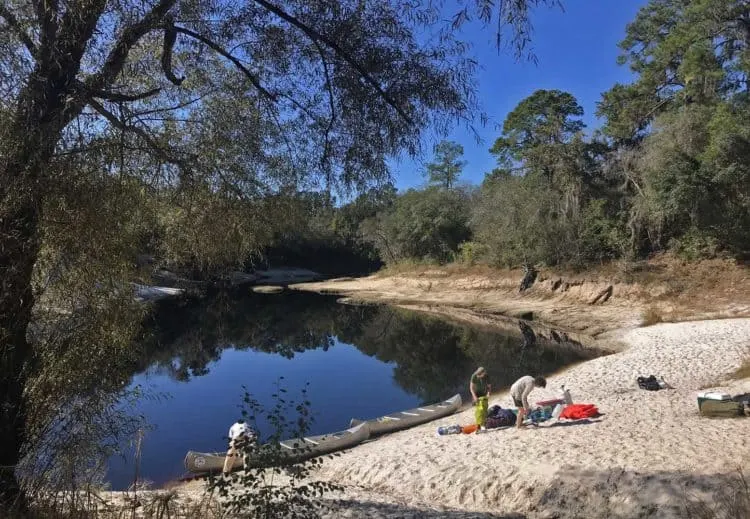
The Suwannee River is divided into three distinct sections
In our mid-November trip, we paddled a section of the Upper Suwannee, which is characterized by craggy limestone bluffs, some 40 feet high. The Upper section is from the Georgia border to where the Withlacoochee joins the river at Suwannee River State Park in Live Oak.
This section, which many consider the most scenic and suitable for paddlers, is actually an ancient shoreline from a time when most of Florida was underwater.
We paddled the upper river at a time of low water level and that meant more of those dramatic cliffs were exposed, with extensive white sandy beaches and shorelines and the roots and knees of gnarly cypress exposed by low water.
In two days of paddling we saw just one other person (and he was at the river camp). A few cabins poked out of the forest; a single house boat sat stuck in low water. Other than that, it was just us, a slow moving river, spectacular skies and an ancient forest in fall colors.
The Middle Suwannee is still rural but a bit more populated. There is still limestone and white sand, but what makes this section appealing is an abundance of fresh springs. The Suwannee has 196 springs and most of them are here. The Middle Suwannee is the area from Suwannee River State Park to Fanning Springs State Park.
The Lower Suwannee, from Fanning Springs to the Gulf, is wide, with low bottomlands and only occasional bluffs. The lower section has two things that make it less appealing to paddlers – because it is wide, it can be windy, and it’s popular with power boats.
Think about the water level in planning your trip on the Suwannee River
An important factor in planning a Suwannee River outing is the water level, which fluctuates dramatically.
High water means swift current and possibly dangerous conditions, especially for less experienced paddlers. If the water level is too low, the Upper Suwannee can be impassable or require you to frequently drag your boat over sandbars or shoals.
It’s difficult to interpret the water levels because Suwannee River Water Management provides the measurement in feet above sea level.
Suwannee Canoe Outpost, the outfitter we used, provides this interpretation of the water levels, but your best bet is to call an outfitter and ask advice.
We paddled during a period of lower water and our outfitter was no longer putting canoes or kayaks in at the park at US 41 bridge, just east of White Springs, where we had planned to start. Instead, he drove us downstream a few miles to launch to avoid shallow areas.
From there, while there were many times we had to maneuver our canoe to avoid sand bars, the water level was not a problem.
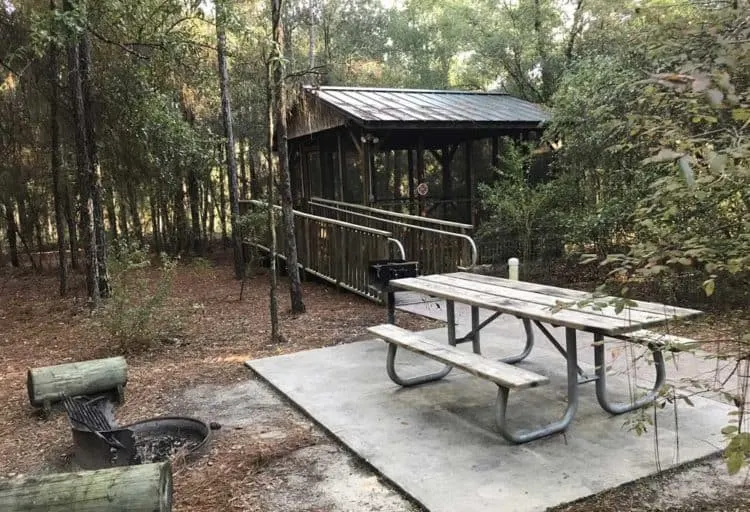
Suwannee River camping at the Suwannee River Camps
We had planned more days of camping, but rain and near-freezing weather prompted us to cut the trip short.
Still, our two days of paddling and one night at the Woods Ferry River Camp were enough to make me a fan, and I want to return and stay in more of the river camps.
Each of the five river camps is designed to be a 10-mile paddle from another campground or river camp.
Our original plan was to start at Stephen Foster Cultural Center State Park in White Springs, where our first night was in a very comfortable state park cabin. Then, Suwannee Outpost would take us to the US 41 bridge to launch and we would paddle 12 miles to the first river camp, Woods Ferry. From there, it would be an 18-mile paddle (about six hours, we estimated) to the second river camp, Holton Creek. On our third day, we would paddle 12 miles to Suwannee River State Park, where we would end our trip with two nights at the state park cabins.
There are many alternate itineraries, including primitive camping on the many sandbars along the Suwannee. One member of our group, a more adventurous camper, thought the sandbar camping would offer a wilder experience with a closer communion with the river.
There are extensive guides and information available for those planning trips at the Suwannee River Wilderness Trail website.
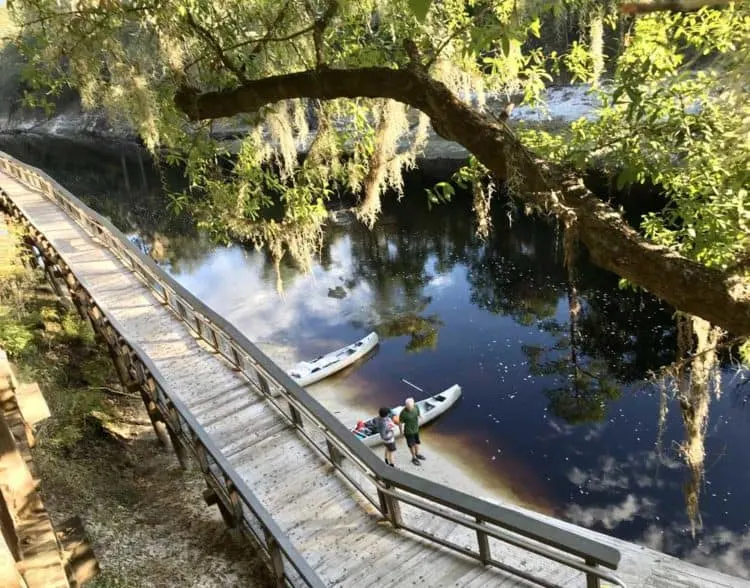
The river camps themselves are a cluster of buildings beautifully integrated into the natural setting. Each has five screened wooden platforms, each of which can sleep eight. Inside, there is an electric light and fan, a light socket and a bench and shelf. Outside, there is a water spigot, a picnic table and a fire ring.
Each river camp has a bath house with hot water for showers, flush toilets and an outdoor “kitchen” sink that makes clean up after meals easier. We appreciated the amenities: Our spotless bathhouse had soap at the sinks and dish soap at the outdoor “kitchen” sink.
The cluster also has a pavilion with picnic tables and a grill, so if it’s raining, you can prepare dinner and dine under roof.
Nearby is a campground that adds capacity to the facility and which has access to the bathhouse and pavilion.
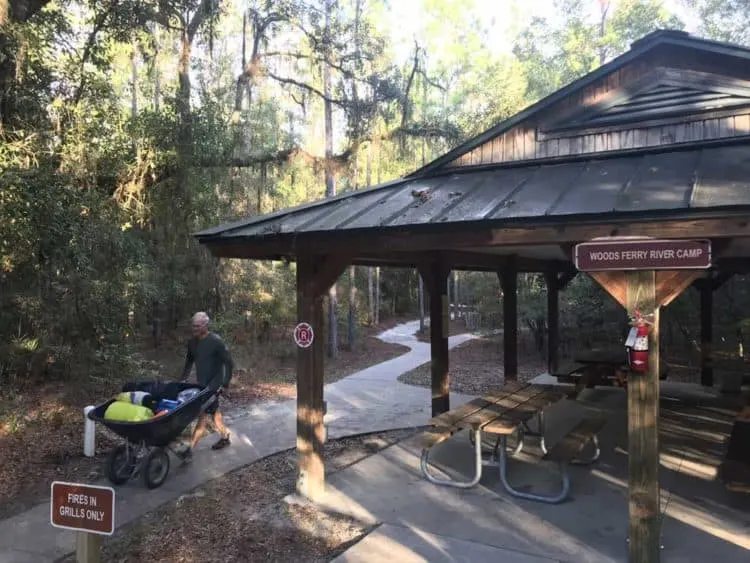
Woods Ferry had a long wooden ramp to get you from the Suwannee’s shoreline to the camp on the bluff. Convenient wheelbarrows helped us move our gear. A camp host was staying in an RV on the property and greeted us and was never seen again.
Unlike other state park campgrounds, river camps, which are free, are only reserved by phone, not via Reserve America. Call 1-800-868-9914.
The camps were built between 2003 and 2010
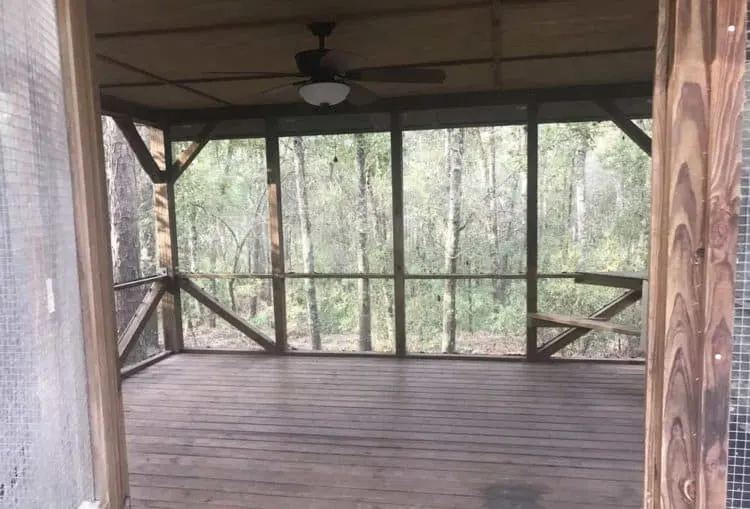
Tips and FAQs about the Suwannee River camping trips
Can I swim in the Suwannee? Members of our group did — on the Upper Suwannee — after asking several different people about it. We did not see any alligators and local residents frequently swim during the day. (It’s wise to avoid swimming at dusk or after dark.) The bright white sandbars made excellent beaches. The Lower Suwannee might be a different story, but there are several springs that are popular and safe swimming holes.
Should I bring a tent, given there are screened covered platforms? A tent is optional. The platforms are separate enough to provide a degree of privacy. If you are going to mix river camps with other campsites or if temperatures will be low, however, you’ll want a tent.
Are the state park cabins in Stephen Foster and Suwannee River State Park accessible to those arriving by kayak or canoe? Generally, yes, although you will have to haul your gear some distance and you’ll have to walk a ways to the ranger station to get the cabin keys. While we got lucky and were able to snag a cabin reservation at the last minute at Suwannee River State Park when the weather turned nasty, it’s best to have reservations. Also: These cabins now have a two-night minimum.
Planning your paddling trip on the Suwannee River
I was overwhelmed at first by what seemed to be the complicated nature of arranging a multi-day trip on the Suwannee. What section should I paddle? Will I be able to get reservations at the river camp? How does that work anyway?
Having completed a successful trip with excellent planning assistance from our friends, I would make these suggestions:
- Decide on a general section of the river and how many days you want to paddle. If it’s your first trip, we recommend the Upper Suwannee for its remarkable scenery.
- Familiarize yourself with the river camps in that section and other camping options, all of which are well described in the links below. Another blogger with lots of experience offers these suggestions.
- Talk to an outfitter (listed in links below.) For the Upper Suwannee, there are two main outfitters –Suwannee Canoe Outpost in Live Oak, which we used for this multi-day trip, and American Canoe Adventure in White Springs, which we have used for day paddles. The outfitter can advise you of water levels and options for where to put in, camp and take out. There will be charges for livery service and kayak or canoe rental.
- Once you decide on your route, contact the Suwannee River Camps office and make a reservation (800-868-9914). The helpful staff person there said the camps do not often fill up and the campgrounds at each site are also a possibility if the platforms are all full. (A reader recently reported that he never reached anybody at this number or got a callback. He went ahead with his trip without reservations. Both campgrounds had host campers and the trip worked out for him.)
Resources for kayaking or canoeing the Suwannee River
- Suwannee River Wilderness Trail website.
- The five Suwannee river camps, including distances between them and special features of each.
- Outfitters for Suwannee river trips. We arranged our trip through Suwannee Canoe Outpost, Live Oak, FL (386) 364-499, located at the Spirit of Suwannee Park, a commercial resort with campgrounds and cabins that organizes music festivals during the year. We have also arranged a day paddle through American Canoe Adventures.
- Suwannee River Paddling Guide, a detailed 72-page guide for paddlers.
- This blogger has excellent advice for those planning a longer camping trip, including where you can buy food along the way.
- Interested in joining a group outing that provides support, transportation and camaraderie? PaddleFlorida.org organizes Suwannee trips every winter. In the past, the Sierra Club has also run Suwannee trips.
Camping and cabins in Suwannee River country
We stayed in terrific cabins in Stephen Foster Folk Culture Center State Park and Suwannee River State Park. Both parks are directly on the Suwannee and also have highly rated campsites. For reservations go to reserve.floridastateparks.org or call 1-800-326-3521, Monday-Friday, from 8 a.m. until 8 p.m. up to 11 months in advance. (They require a two-night minimum, which is left helpful to those through-kayaking.)
Here’s our report on Stephen Foster Folk Center State Park, and its very odd and dated museum about Stephen Foster and its excellent cabins.
We’ve also stayed in great cabins at Fanning Springs State Park on the Suwannee at the point where the Middle Suwannee becomes the Lower Suwannee. Fanning Springs is very close to Manatee Springs, where there is camping. (Information in the above story about Fanning Springs.)
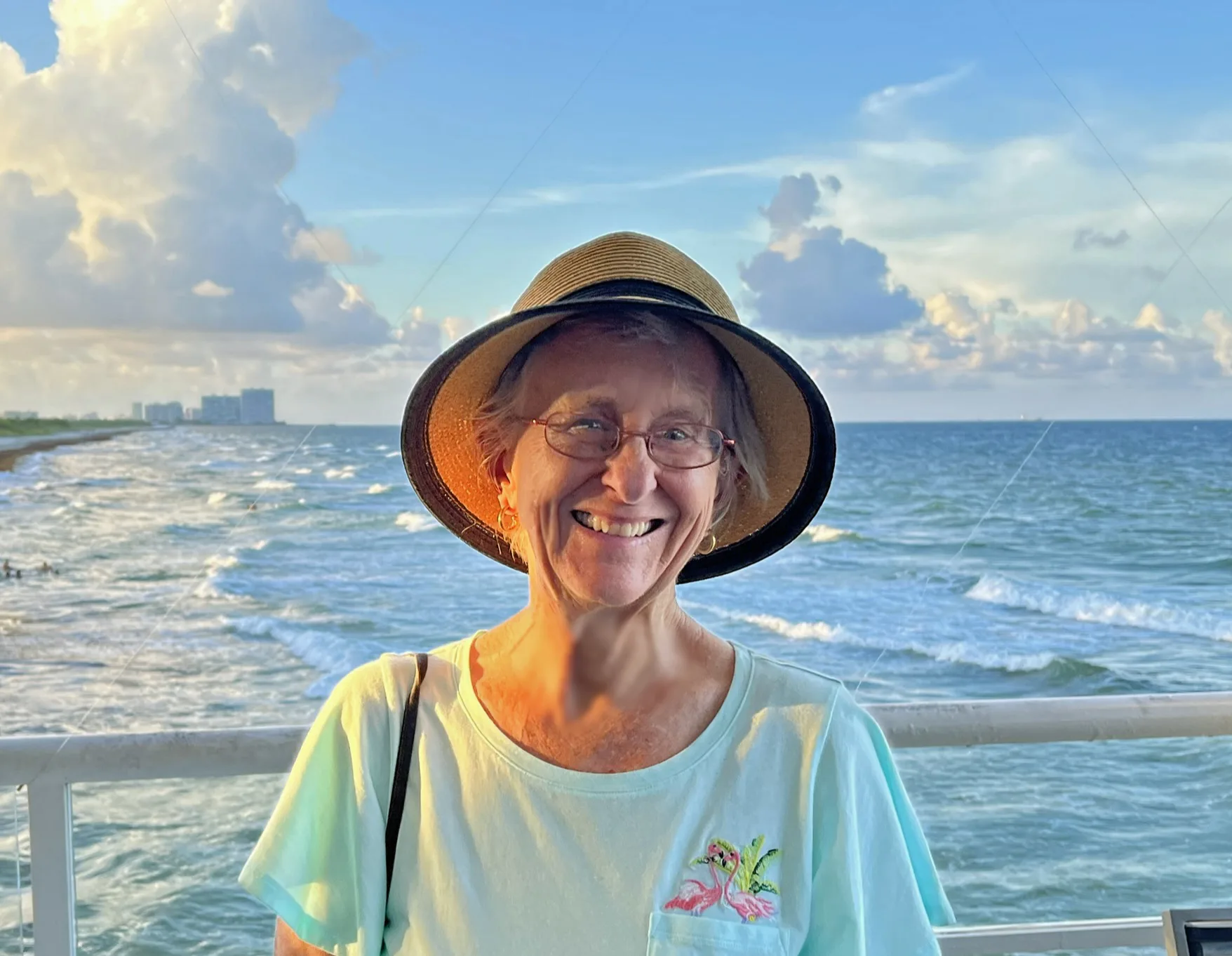
The author, Bonnie Gross, travels with her husband David Blasco, discovering off-the-beaten path places to hike, kayak, bike, swim and explore. Florida Rambler was founded in 2010 by Bonnie and fellow journalist Bob Rountree, two long-time Florida residents who have spent decades exploring the Florida outdoors. Their articles have been published in the Sun Sentinel, the Miami Herald, the Orlando Sentinel, The Guardian and Visit Florida.

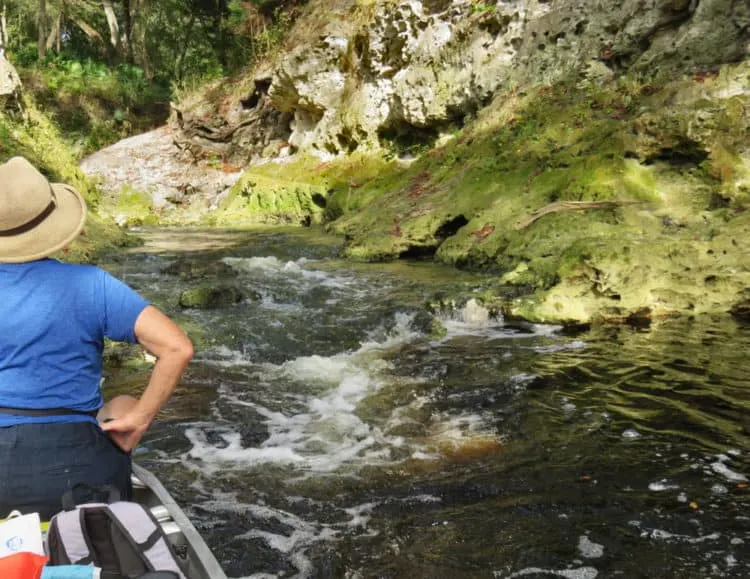
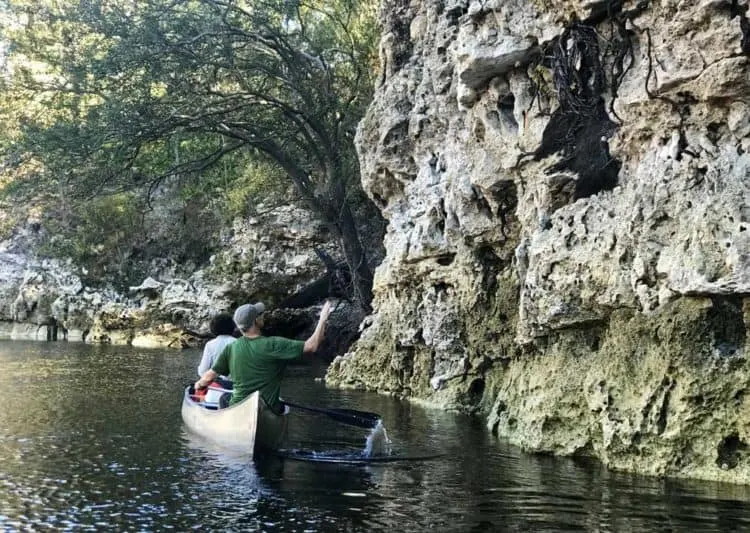
James
Friday 21st of April 2023
4.21.23: Steve from Suwannee Canoe Outpost shuttled our inflatable from Spirit of Suwannee (Live Oak) to a very remote put-in 6.5 miles upstream. 3.5 hrs easy paddling back, with stops on sunny sandy beaches that appeared from nowhere and which dropped into deep tannic water. Low river level, slight current, plenty of depth but for some random, avoidable downed trees. Kayaking hemmed in by limestone cliffs anchored by old cypress is quietly impressive, so unlike the rest of Florida rivers (didn't see any gators). "Land that time forgot" was the feeling. Only 1 other boater for the first 5 miles; then state park generated some polite traffic. All in all, a great, long-awaited trip: just make the drive there on the back roads thru wild-flowered agricultural scenery & go.
John Pretzell
Tuesday 15th of February 2022
All info here is true. With this one exception !!!! I 'very paddled the whole Suwannee River from the Duke in Georgia to the Gulf & it was a great experience, I 've stayed in all of the River Camp & met great :Hist Campers" along the way. But currently they are not available to set reservations, I have left several messages at the SRPT office phone line w/o any return calls. Still planning a Spring run with 19 others, but no confirmation from there office to set up dates, I know back in the 2000's it "was always open for solo paddlers along the trail". Hope it still goes fir groups currently, since they di not answer the messages. JP
Thomas Haynie
Tuesday 4th of August 2020
Great post, good information - well done
Jack Maney
Wednesday 26th of February 2020
Please let me know where you took this photo https://www.floridarambler.com/florida-camping/suwannee-river-camps-for-canoe-kayak/attachment/suwanee-bluff-close/ so I can take my sister canoeing where the best carved limestone cliffs are. I have paddled all of it :) but can't remember where. Thanks!
Bonnie Gross
Friday 28th of February 2020
I'm pretty sure that was in the Upper Suwanee section, between Stephen Foster State Park and Woods Ferry River Camp (roughly mile 169 to 160.)
WILLIAM WISE
Sunday 16th of February 2020
My favorite Suwanee section is the part flowing through the Okefenokee National Wildlife Refuge. I try to visit the Okefenokee at least every other year. Always great photography opportunities and a chance to get away... really get away!